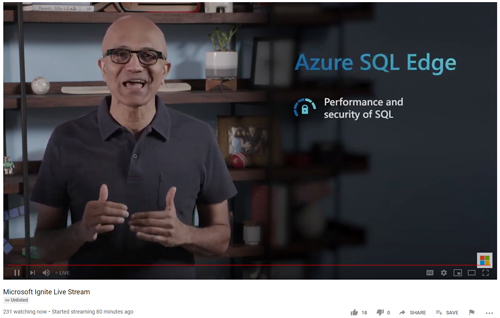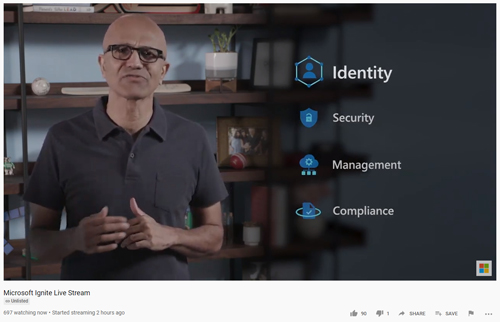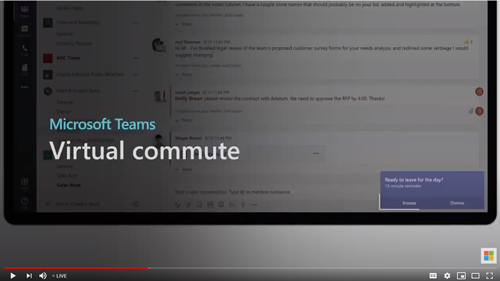Posey's Tips & Tricks
Microsoft Ignite 2020 Reaction, Part 1: A New Normal for Tech Conferences
Something about Satya Nadella's opening keynote makes Brien wonder if Microsoft thinks we'd all be better off doing everything -- including conferences like Ignite -- remotely, even after the pandemic is over.
I just finished watching Microsoft CEO Satya Nadella's opening keynote for Microsoft Ignite 2020 and wanted to share my thoughts about his presentation. My purpose isn't to rehash all of the announcements (although I will be mentioning a few in Part 2), but rather to share my observations and impressions, and my thoughts on what the future might look like.
One of the things that I was really curious about prior to the start of Ignite was attendance. Ignite is normally a huge event with somewhere between 20,000 and 30,000 people attending in person and millions more watching online. This year, of course, the entire event is virtual.
A few months ago, I wrote a column questioning whether virtual conferences can ever compare to live events. One of the points I made was that attending an event in person makes it much easier to focus on the event. When you are at home, it's way too easy to get bogged down by day-to-day distractions. Just last week, in fact, I had to turn down multiple online meetings that would have overlapped with the Ignite keynote. I'm sure plenty of other people had similar scheduling issues.
Only Microsoft knows for sure how many people actually watched the event live. Based on my own observations, however, the keynote was not well-attended (although keep in mind that I am only basing this on the YouTube live stream).
I took two screen captures of the live event. The first was probably taken about 15 or 20 minutes into the presentation. As you can see in Figure 1, only 231 people were watching at the time.
 [Click on image for larger view.] Figure 1: Only 231 people were watching live.
[Click on image for larger view.] Figure 1: Only 231 people were watching live.
As I watched the keynote, more and more people kept joining so I took a second screen capture near the end of the event. Even then, there were fewer than 700 people watching (although the count did eventually spike over 700).
 [Click on image for larger view.] Figure 2: Fewer than 700 people were watching at this point.
[Click on image for larger view.] Figure 2: Fewer than 700 people were watching at this point.
I say all of this to underscore the point that virtual events simply are not as engaging as in-person events. It's too easy to skip a virtual event to make time for more pressing matters. Even so, I have to confess that by the time the event was over, I was left wondering if Ignite would ever be in-person again
A few weeks ago, I laid out a few of my predictions for the Ignite opening keynote. Overall, my predictions were right on track. Of course, it wasn't exactly difficult to guess that Microsoft would try to stick to its usual Ignite keynote format, or that it would spend a lot of time talking about the pandemic and Microsoft Teams. Even so, there was one prediction that I seem to have gotten wrong.
I predicted that the keynote would focus heavily on all the things that Microsoft is doing to help with the transition back to normal life when the world eventually reopens. Instead, Nadella seemed to lean the opposite direction. Maybe it was nothing more than my own errant perception, but I was left with the impression that Microsoft expects us all to remain isolated indefinitely -- maybe forever.
Granted, Nadella did not say that, but the idea seemed to be implied by the frequent use of phrases such as "remote everything" and a discussion of new Teams features designed to help mimic normal life. One of the demos even showed a virtual commute being added to Teams, as shown in Figure 3, which is said to help add structure to the work day.
 [Click on image for larger view.] Figure 3: Microsoft Teams is getting a virtual commute feature.
[Click on image for larger view.] Figure 3: Microsoft Teams is getting a virtual commute feature.
Nadella also talked about the ways in which employees struggle with work/life balance while working remotely, and even went so far as to bring in a former Buddhist monk to talk about meditation, mindfulness and well-being.
I applaud Microsoft for taking steps to help work-from-home employees regain a sense of well-being and a separation between their work and personal lives. Ultimately, though, I was left with the impression that Microsoft is not optimistic about the world returning to normal anytime soon, and that perhaps there are those within Microsoft who think we are all better off doing everything -- including conferences like Ignite -- remotely, even after the pandemic is over. Again, this is just my perception. It's entirely possible that I could be misinterpreting the message that Microsoft was trying to convey.
At any rate, the Ignite keynote focused on much more than just the pandemic and work-from-home solutions. In Part 2 of this series, I'll turn my attention to some of the technology that Microsoft demonstrated during its Ignite keynote.
About the Author
Brien Posey is a 22-time Microsoft MVP with decades of IT experience. As a freelance writer, Posey has written thousands of articles and contributed to several dozen books on a wide variety of IT topics. Prior to going freelance, Posey was a CIO for a national chain of hospitals and health care facilities. He has also served as a network administrator for some of the country's largest insurance companies and for the Department of Defense at Fort Knox. In addition to his continued work in IT, Posey has spent the last several years actively training as a commercial scientist-astronaut candidate in preparation to fly on a mission to study polar mesospheric clouds from space. You can follow his spaceflight training on his Web site.